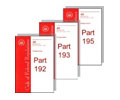Drug and Alcohol Testing Program Overview
 The PHMSA Drug and Alcohol (D&A) testing regulations in 49 CFR Part 199 require operators of pipeline facilities subject to 49 CFR Parts 192, 193, and 195 to test covered employees for the presence of prohibited drugs and alcohol.
The PHMSA Drug and Alcohol (D&A) testing regulations in 49 CFR Part 199 require operators of pipeline facilities subject to 49 CFR Parts 192, 193, and 195 to test covered employees for the presence of prohibited drugs and alcohol.
- Part 192 regulates pipelines used to transport natural gas and other gas.
- Part 193 regulates liquefied natural gas (LNG) facilities used in the transportation of gas by pipelines subject to the pipeline safety regulations in Part 192.
- Part 195 regulates pipelines used to transport hazardous liquids or carbon dioxide.
 Operators must conduct the required PHMSA D&A testing using the DOT's Procedures for Transportation Workplace Drug and Alcohol Testing Programs in 49 CFR Part 40.
Operators must conduct the required PHMSA D&A testing using the DOT's Procedures for Transportation Workplace Drug and Alcohol Testing Programs in 49 CFR Part 40.
Part 199 requires operators to have a written
At a minimum, written plans are intended to supplement, not to paraphrase or regurgitate the regulations with the specific methods and procedures the operator uses to meet the regulations in Part 199 and Part 40. Refer to the code for additional plan requirements.
Operators must have a process to identify the "covered employees" who perform "covered functions" on the regulated pipelines or LNG facilities. Covered functions means an operations, maintenance, or emergency-response function regulated by Part 192, 193, or 195 that is performed on a pipeline or on an LNG facility. Covered employees include persons employed by operators, contractors engaged by operators, and persons employed by such contractors.
The PHMSA D&A regulations allow contractors to carry out the drug testing, education, and training required by Part 199 provided there is a written contract between the operator and the contractor. The operator also remains responsible for ensuring the requirements of Part 199 are complied with and that the contractor allows access to property and records by the operator, PHMSA, and if the operator is subject to the jurisdiction of a state agency, a representative of the state agency for the purpose of monitoring the operator's compliance with the requirements of Part 199.
Drug testing under 49 CFR Part 199, Subpart B, is conducted as follows:
- Pre-employment (new hires and employees transferring into a covered position)
- Post-accident (after PHMSA reportable accident)
- Random
- Reasonable cause
- Return-to-duty (after failing or refusing a drug test)
- Follow-up (according to SAP instructions after passing a return-to-duty test)
Alcohol testing under 49 CFR Part 199, Subpart C, is conducted as follows:
- Pre-employment (optional)
- Post-accident (after a PHMSA reportable accident)
- Reasonable suspicion
- Return-to-duty (after failing or refusing an alcohol test)
- Follow-up (according to SAP instructions after passing a return-to-duty test)
